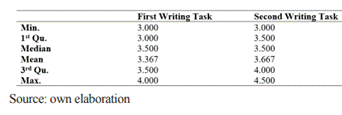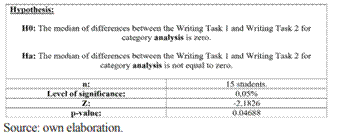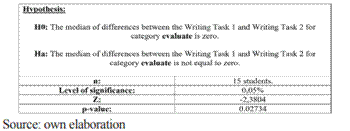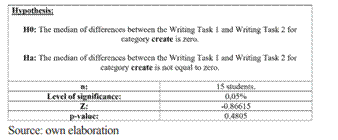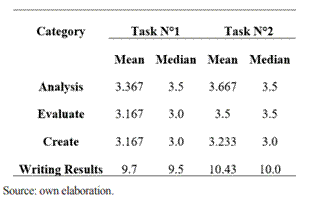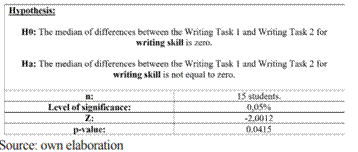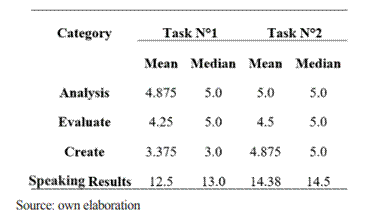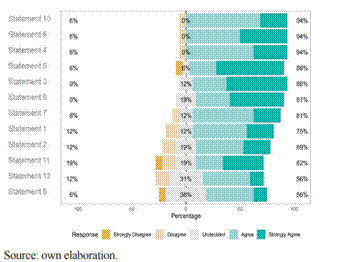Introducción
The most general meaning of the term critical thinking refers to a higher process of thinking, in which the individual analyzes the information gathered in a logical and reasonable way to achieve a reflective conclusion, belief, or action (Bezanilla et al., 2021; Koleñáková et al., 2020; Saulius & Malinauskas, 2021). This skill is reported to be one of the most important intellectual skills which contributes to students’ academic and professional success (Liu, et al., 2014). Similarly, this idea of critical thinking is closely tied to the higher-order thinking skills (analyze, evaluate, and create) found in the revised Bloom’s taxonomy (Conklin, 2005). Regarding the specific areas of the skill, Facione (2011) states that the core critical thinking skills correspond to interpretation, analysis, evaluation, inference, explanation, and self-regulation.
Critical thinking skills should be taught from an early age as they help in life to make wise decisions, be better prepared to express thoughts and opinions, and generate novel ideas to solve problems efficiently. Critical thinking education needs to be promoted all along with the teaching and learning processes. In college undergraduates and postgraduate students are required when doing research to analyze, question, and reflect on the information they are presented with. Accordingly, Erdogan (2019), argues that there is a close connection between communication and critical thinking skills because critical thinking allows students to assess the relevance and accuracy of the information they are presented with, they also analyze and evaluate different sources of information, make rational and well-informed decisions, and take determined action.
In an English Teaching Program study plan from a Chilean higher education institution, it is clearly stated in the English Language I course for first-year undergraduate students that they should be able to carry out speaking tasks which involve discussion and a direct exchange of information on familiar and routine matters using grammatical structures and vocabulary appropriate to a A2 level, according to the CEFR (Council of Europe, 2001). Pratiwi (2018) claims that those students who have good critical thinking tend to exhibit good speaking skills in class. Rameezani et al. (2016) agree with this idea and state that students’ ability to speak improves significantly when they increase their critical thinking skills. Additionally, in the same course program, it is expected from students to be able to write a text in both formal and informal register and to precisely integrate lexical-semantic, grammatical, and phonetic phonological elements into spontaneous interactions. These tasks demand from students the development of higher order critical thinking skills as they are required to go beyond rote memorization. They should be able to categorize, infer, connect ideas, analyze, and evaluate situations.
Although the English Language I course includes different tasks aimed at developing communicative competence among first-year undergraduate students; the academic team of professors in charge of this course have identified an important deficiency among students’ critical thinking skills, which is evidenced in their low level of oral and written production; namely, insufficient vocabulary, simple oral and written messages, and ultimately, superficial reasoning to produce opinions and judgements, which do not meet the standards set in the Common European Framework of References (Council of Europe, 2001). This issue has become a major concern since critical thinking skills development is one of the most important learning outcomes to be developed at the end of the year. This problem worsened in the context of the pandemic as teaching was undertaken remotely, and lessons were taught online by using platforms like Canvas and Teams. As a result, the level of interaction between teachers and students diminished and a reduction of opportunities for learners to practice the language was perceived. Slow internet connection or limited access from home were important problems students faced during the pandemic context, which had notorious effects upon their level of engagement clearly evidenced in the lack of attendance, participation, and low levels of autonomy for working on asynchronous assignments.
To solve this problem, the following action research aimed at using a series of short, animated videos to improve first-year university students’ critical thinking skills development in both writing and speaking skills. The videos selected were used as a meaningful input to make undergraduates reflect, analyze, and evaluate the situations presented. This initiative was supported by the funds provided by the university to carry out projects (Proyecto Inicia 2019064) focused on improving students’ competences.
Literature review definition of critical thinking skills
The oldest concepts related to this term were developed by Socrates. He thought that an individual could achieve a higher and deeper thinking process if asked the correct questions, and thus form an opinion based on solid evidence and extensive reasoning (Paul et al., 1997). Questioning is at the core of critical thinking as information needs to be examined objectively and opinions must be substantiated by evidence. Critical thinkers are open-minded and willing to restructure their own views and opinions after careful evaluation of the evidence; hence, their thoughts are in continuous improvement due to this systematic analysis. Individuals who develop these capabilities are in a better position to make sound judgments and informed decisions. (EalesReynolds et al., 2013).
Scriven and Paul (2007, p.1 as cited in Koleñáková et al., 2020) explained the idea of critical thinking as a procedure that incorporates several mental processes, such as conceptualizing, analyzing, applying, and evaluating information gathered. In this task, higher mental processes are involved, including making decisions, solving problems, and making a judgment. Furthermore, critical thinking has been regarded as the opposite of spontaneously generated judgements of a situation (Saulius & Malinauskas, 2021). Accordingly, when learners are encouraged to use background knowledge, interpret, analyze, and manipulate information in order to solve a problem, their critical thinking increases (Amin & Adian- syah, 2018).
Critical thinking skills are developed naturally through life, parallel to the growth of the individual, but this development can be affected by external factors that prevent the individual from using these skills (Gilmanshina et al., 2021). In this regard, experts have come to the conclusions that academic and nonacademic experiences together determine critical thinking (Terenzini et al.,1995). Nonetheless, Jean Piaget claimed that it would be impossible to "teach" critical thinking from scratch (Halonen, 1995). Further research also adds that critical thinking can even be enhanced through exercise and practice, especially during school days (Ketabi et al, 2013).
Among the benefits of developing critical thinking skills, it is found that it facilitates learning and boosts creativity, contributes to problem-solving, and decision making, among other competences of this modern era (Bezanilla et al., 2021). Additionally, students would become more independent through the improvement of their critical thinking skills and vice versa (Kopzhassarova et al., 2016).
Bloom’s taxonomy and critical thinking
Bloom’s taxonomy consists of six hierarchical categories of cognitive processes in which students are classified according to their observable behavior (Athanassiou et al, 2003). The taxonomy was revised in 2001 and categories were reorganized as follows: remembering, understanding, applying, analyzing, evaluating, and creating (Anderson & Krathwohl, 2001). In the case of the three latter, they are regarded as the "high-order thinking skills", and they are closely tied to the concept of critical thinking (Conklin, 2005). Furthermore, this revision labels knowledge in 4 dimensions: factual, conceptual, procedural, and metacognitive (Adams, 2015). For example, in the metacognitive knowledge dimension, the learning objectives correspond to the higher-order thinking skills analyzing, evaluating, and creating.
In several research projects, both Bloom’s taxonomy and critical thinking have been implemented successfully together in varied educational settings, emphasizing the different benefits they bring to learners such as the improvement of metacognition and self-responsibility (Athanassiou et al., 2003; Bissell & Lemons, 2006) and the recognition of strengths and weaknesses, as well as evaluating their peers (Nentl & Zietlow, 2008). Nevertheless, the application of Bloom’s taxonomy has not been recommended to be applied in certain areas that concern arts and creativity, such as English literature (Rahman & Manaf, 2017). It should be noted that for the purpose of this study, Blooms’ taxonomy was used because during the Course Language I, first year undergraduate students are progressively moving towards the upper levels of the taxonomy in question.
Critical thinking skills in writing
Regarding the connection that there exists between critical thinking skills and writing, Rahmat (2020) stated that thinking critically is embedded within the process of academic writing, since the production of a text involves problem-solving, decision-making, discerning and selecting information, and assessing the final product. Similarly, concerning strategies to develop critical thinking skills in writing, Peirce (2005) suggested that an effective way is teaching students note-taking strategies and engaging them in informal writing tasks. Moreover, students can improve higher-order skills with concept mapping, especially, by freely creating the map themselves using the concepts of their knowledge (Tseng, 2019).
Furthermore, non-traditional writing tasks also have shown to be greatly valuable to be used and to improve not only the students’ set of critical thinking skills but also to improve their writing skills (Sinaga & Feranie, 2017). Non-traditional writing refers to the idea of using a variety of audiences for the student to create a text, which makes the individual think and consider how to explain the text differently, in contrast to traditional writing, which is the student-teacher type of writing (Kingir, 2013). Additionally, in the research conducted by Çavdar and Doe (2012) attention was drawn to the concept of scaffolding through the usage of "feedback loops" between students and teachers throughout the process of writing. Finally, Watanabe-Crockett (2016) in his workbook called "The Critical Thinking Workbook" suggests a series of interesting activities which can be implemented in the EFL classroom. Some of these activities are the following: Fact or Opinion, What Would happen? You Know the Rules, You Name it, and The Worst-Case Scenario.
Critical thinking skills in speaking
The development of critical thinking skills has a positive impact on EFL speaking skills or vice versa. In this regard, in a study conducted by Rahmawati (2018), conversational skills positively correlated with high levels of critical thinking. Accordingly, it has been demonstrated that the explicit instruction of such skills has a positive impact on EFL learners’ oral performance (Malmir & Shoorcheh, 2012) and speaking proficiency (Sanavi & Tarighat, 2014). Furthermore, these higherorder thinking skills help learners to raise awareness of academic debate by bringing information to discuss and question in the classroom (Muhammadiyeva et al., 2020). An approach to teaching this ability of critical thinking is one based on Socratic questioning, which involves the usage of a series of questions of increasing complexity to explore ideas regarding a specific subject. In this sense, it has been proved that Socratic questioning did not only improve the student’s speaking skills, but also improved their critical thinking (Manurung & Siregar, 2018).
Another useful technique to promote this competency in speaking is Digital Storytelling, which is one of the Web 2.0 tools that promotes creativity in writing. When this method is used, different aspects of the writing skills are developed simultaneously, as the task involves arranging the main ideas and exploring new ways of thinking differently; moreover, learners have fun in the process (Saputro, 2013). Similarly, Syafryadin (2019) discovered that the implementation of Digital Storytelling significantly enhances students’ speaking ability, as well as assists them to become more critical, creative, and confident as a digital generation. Moreover, Watanabe-Crockett (2016) in The Critical Thinking Workbook suggests four speaking activities to develop their cognitive and communicative skills: Debate, Facts or Opinions, Coffee House Chat, Alien Travel Guide, and Case Study.
Critical thinking skills using videos
The use of audiovisual material to enhance critical thinking skills has been a widely used strategy. Hakes (2008) offers some suggestions on how to use scenes from movies to make students analyze different conversations or attitudes expressed by the characters. Students are invited to evaluate the decisions or arguments made and establish relationships between behaviors and outcomes. Activities that appeal to emotions tend to trigger reasoning, lead to more discussion, and encourage students to rethink and revise their own arguments on the issues presented.
In a study carried out by Guhde (2010), it was observed that participants reflected on their own learning process and as a result increased their awareness about assessment. Furthermore, it was found that instruction based on videos had a significant positive impact on critical thinking skills (Budiarti et al., 2020). In addition, Ritonga et al., (2020) concluded that the use of problembased videos is effective in improving critical thinking skills compared to using non-animated vi deos. More specifically, the well-known video platform "YouTube" has been demonstrated to be a stimulating teaching tool that improves students’ engagement, participation, and critical thinking skills (June et al., 2014; June et al., 2014).
Atayeva et al. (2019), in their research, used short videos to develop Indonesian Junior high school students’ critical thinking skills. The results of the study revealed that students’ critical thinking skills had not improved significantly, nonetheless, they had an excellent performance regarding their collaborative skills. Some other strategies teachers can use to monitor how students develop their critical thinking skills are the following: providing students with rich feedback, deep questioning, and formative assessment where students can clearly see expected learning outcomes (Gunawardena & Wilson, 2021).
Critical thinking skills in the Chilean EFL classroom: national guidelines
In 2014, the Ministry of Education in Chile (MINEDUC) commissioned the elaboration of specific standards for all graduates of English teaching programs in the country. The main purpose of these standards was to provide guidelines for higher education institutions regarding essential skills and knowledge graduates were expected to achieve at the end of the program to deliver an effective lesson in the Chilean classroom. These standards are divided into two main areas, namely disciplinary standards, and pedagogical standards. The latter subdivided into two: pedagogical standards for elementary education and pedagogical standards for secondary education (MINEDUC, 2014). Furthermore, some of the standards are directly connected with teaching and developing students 'critical thinking skills. So, teachers should design and plan activities that promote students’ critical and creative thinking as well as analyze the national educational policies, their issues, and advances in the English teaching-learning field (MINEDUC, 2014). Therefore, graduates inherently require the development and practice of critical thinking skills during their learning process in higher education.
Critical thinking skills in the Chilean educational context
In the Chilean educational system, the curriculum has been criticized since it does not emphasize the importance of critical thinking skills. This can be evidenced in Porter’s (2018) comment when he states that the dominant pedagogical approach of the Chilean educational system is a "banking type" of education, in which students are depositories of information, who are detached from their reality and solely oriented to the preparation of standardized tests. Consequently, after attending school for many years, students would leave school without scarce critical thinking skills, creativity, transformation, or knowledge and turn into passive citizens who lack critical consciousness (Freire, 2004).
The Chilean scenario of higher education seems not to be different. Betancourth-Zambrano et al. (2017) carried out a study that sought to evaluate problem-solving skills among 141 undergraduate law students in a Chilean university. The results demonstrated that, in general, the participants presented a low level of critical thinking development. Moreover, in a study carried out by Ossa Cornejo et al. (2018), among 141 students from 4 different teaching programs at Universidad del Bio-Bío revealed that the level of critical thinking in scientific reasoning presented by the students was moderately developed. According to Gunawardena and Wilson (2021), the reason behind the low levels of critical thinking was the students’ lack of motivation, unclear goals, and their poor preparation for university, particularly regarding critical reading and general knowledge about their subject areas.
Research design
Type of study
The following study corresponds to an action research study. Ferrance (2000) defines action research as a type of research carried out in the context of the teachers’ environment where they examine their own educational practices carefully and systematically utilizing the techniques of research to gather data and improve areas. Altrichter et al. (2007) add that this research is a cyclical process in which researchers collect data, interpret the information, arrive at ideas for action, then take actions, and the cycle continues.
General objective
To assess the effectiveness of short, animated videos to improve first-year undergraduate students’ critical thinking skills in speaking and writing skills.
Specific objectives
To compare first-year undergraduates’ critical thinking skills development in the categories of analysis, evaluation and creation in the writing and speaking skills at the end of the intervention.
To explore first-year undergraduates’perceptions regarding their critical thinking skills development in writing and speaking skills in the categories of analysis, evaluation, and creation.
Participants
The action research was conducted in a Chilean higher education institution. Among the degrees this university offers are the English language Teaching degree. The sample chosen for this research corresponds to a convenience sample. This sampling method uses examinees who are "convenient" to the researchers and there is not a pattern to recruit them (Kempf-Leonard (2004). The participants were a group of first-year undergraduate students in an age range of 18 to 22 years old. They were enrolled in the English Language I Course. They were all expected to achieve a pre intermediate level of English (A2) at the end of the course (Council of Europe, 2001). The researchers were the two professors in charge of conducting the intervention in the Language I Course during the first academic term. The original sample was made up of 22 students; however, due to the pandemic context and the connectivity issues that emerged, not all students were able to successfully complete the writing and speaking tasks assigned. In the writing tasks, 16 students finished the two tasks which were assessed, and in the speaking tasks, 8 students completed both oral assignments. All classes were undertaken remotely on Canvas and TEAMS platforms where they uploaded their assignments and joined the live sessions.
Action research intervention plan
The intervention plan developed in this study comprised nine 90-minute online sessions in all and the sessions took place once a week on the LMS Canvas and the communication platform Teams provided by the university. It was developed in the Language I Course of the study plan, and it was conducted during the first semester of 2021, during the COVID-19 crisis. From these nine sessions, four of them were planned to develop critical thinking skills in speaking. In the same way, the remaining five sessions aimed at developing critical thinking skills in writing. All sessions were under the responsibility of the two professors who shared the same English language I course. The writing activities required students to watch a short, animated video, analyze the situations presented, evaluate the characters’ behaviors, check the new vocabulary, and end up with a writing assignment (a personal reflection, a piece of advice, a description, etc.). In the case of the speaking tasks, students were presented with a short, animated video, they had to discuss the content, analyze the different situations, and create a motto, prepare a 3-minute talk, or create a Flipgrid activity, among others. Besides, some ICT tools such as Nearpod, Flipgrid, Genially and Jamboard were incorporated in some of the sessions to engage students in their learning and allow them to take part in collaborative work. From all the activities developed by students in both writing and speaking, only two formative tasks from each language skill were assessed according to the higher-order critical thinking skills selected: analyze, evaluate, and create.
Data collection techniques
The data gathered from the intervention were analyzed using the following instruments:
Speaking tasks: four speaking tasks were planned during the whole intervention and two of them were assessed with an analytic rubric to check students’ improvement in their higher-order critical thinking skills: analysis, evaluation, and creation. The first speaking task assessed was based on the video "An experiment of gratitude" (https://youtu.be/ Y3cpV_dnN_I). Students discussed orally the main theme of the video, analyzed the character’s change of attitude, and evaluated it by giving reasons for this change. As a final product, they had to prepare a 3-minute talk on gratitude in which they had to devise at least two ways in which they could express gratitude. The second speaking task was based on the short video "Boundin" (https://www.youtube.com/ watch?v=7WyR4AqRweY). Students discussed, analyzed, and evaluated the moral from the video. Each student was required to create a video on Flipgrid, where they extrapolated the moral to their own lives and to our own society.
Writing tasks: five writing tasks were planned in the intervention and two of them were assessed to analyze students’ improvement in their higher-order critical thinking skills. The first written activity assessed was based on the video "The Other Pair" (https:// www.youtube.com/watch?v=XYWnSWvpj_c&ab_ channel=Let%27sPrepare). Students watched the video and analyzed the topic. They had to choose one of the characters from the video, speculate about his personality, background, family, etc. and they had to write a description in the first part of the activity and in the second part, they had to simulate they were reporters and create questions to be asked to the character chosen. For the second written assessment activity, students watched the video "My School Memories" https:// www.youtube.com/watch?v=5cVpxzy72uU&ab_ channel=SimplySoumojit) and they analyzed the situations related to school lives, evaluated the experiences, wrote a personal reflection based on specific aspects, and finished it with a famous quote.
Analytics rubrics: To assess students’ critical thinking skills development in the speaking and writing tasks, two analytic rubrics were created. Both rubrics were designed taking into consideration Bloom’s taxonomy’s high order thinking skills: analysis, evaluation, and creation. The rubric descriptors provided specific information about what students were expected to meet on each level of performance, ranging from the minimum score corresponding to the emerging descriptor (1 point) to the maximum score, which corresponded to mastering descriptor (5 points).
A likert scale survey: this online survey (https://docs.google.com/forms/d/e/1FAIpQLSf3 LCEMoZcMMmrAfEctKRd0oRh5f6SdGEWS_ C2Km2XlRQkqLw/viewform) was used to assess students’ perceptions about their critical thinking skills’ improvement in both writing and speaking skills. It consisted of twelve statements and the possible answers for each statement ranged from Strongly Disagree (1) to Strongly Agree (5).
Data analysis techniques
The data gathered was analyzed by using a free software for statistical computing and graphics called R (version 3.6.3). The data techniques used to analyze the information were was descriptive statistics, more specifically, measures of central tendency, particularly, mean, and median values and the data is displayed in graphs and charts. Furthermore, the non-parametric Wilcoxson test was also applied in the writing skill analysis to seek whether the data collected was statistically significant or not.
Results
The results analysis is divided into three main aspects: students’ critical thinking skill development in writing, in speaking and students’ perceptions about the intervention. Furthermore, writing and speaking skills results were subdivided into four main categories which corresponded to the three higher-order critical thinking skills assessed: analyze, evaluate, and create. Besides, a global analysis for each productive skill is provided.
Results analysis in writing skill critical thinking skill assessed in writing: analysis
Figure 1 shows the measures of central tendency in the writing skill in the category Analysis. It can be observed that there was no change in the median, but there was an increase in the mean values between the first and the second writing task. Similarly, there was an increase in the maximum of the results of the second writing task.
Wilcoxon signed-rank test analysis
The non-parametric Wilcoxon test was used to corroborate if the observed improvement in this category (Analysis) was statistically significant. The results indicated that the p-value=0.047 was lower than alpha value (α=0,05), thus, the increase was statistically significant.
Critical thinking skill assessed in writing: evaluate
Figure 3 shows the measures of central tendency in the writing skill in the category Evaluate. According to the data presented in the following table, an increase was observed in both the mean and the median results in the second writing task, as well as in both the maximum and the minimum scores of the results in the second writing task.
Wilcoxon signed-rank test analysis in the writing skill: evaluate
The Wilcoxon test showed that the improvement in the category Evaluate was statistically significant, as the p-value= 0.027 was lower than the alpha value (α = 0.05).
Critical thinking skill assessed in writing: create
Figure 5 shows the measures of central tendency and a slight increase can be observed in the mean scores, while the median remained the same. Although the maximum score increased, there was a new minimum score in the second writing task as well.
Wilcoxon signed test in the writing skill: create
In contrast to the previous categories Analysis and Evaluate, the Wilcoxon test indicated in this category a p=0.48, being a value higher than alpha value (α=0,05). As a result, the increase observed in the writing task 2 was not statistically significant.
Global analysis of the three critical thinking skills assessed in writing
According to the data presented in Figure 7, an increase can be observed in the mean values in the three categories assessed (Analysis, Evaluate and Create) in writing. Concurrently, the median remained the same in the second writing task in the category of Analysis and Create.
Wilcoxon signed-rank test global analysis
In this case, the Wilcoxon test showed a p=0.0415, being a value lower than the alpha value (α=0.05), which indicates that the increase observed in writing task 2 compared to writing task 1 was statistically significant.
Speaking skill results analysis
Since the number of students who submitted both speaking tasks assessed was small, the tests’ measurements collected were insufficient to be analyzed with the non-parametric Wilcoxon test. Therefore, the results obtained were not statistically significant. Nonetheless, it was possible to see an increase in the measures of central tendency, specifically in the mean values.
Critical thinking skill assessed in speaking: analysis
Figure 9 shows that there was no change in the median. In addition, there is a slight increase in the mean values in the second speaking task. The maximum score of the second speaking task remained the same, and the minimum scores improved.
Critical thinking skill assessed speaking: evaluate
Figure 10 shows the measures of central tendency in the speaking skill for the category Evaluate. It can be observed that there was no change in the median. In addition, it is observed that there was a slight increase in the mean results in the second speaking task. The maximum and the minimum scores of the results of the second speaking task remained the same.
Critical thinking skill assessed: create
Figure 11 shows the measures of central tendency in the speaking skill for the category Create. It can be observed that there was a remarkable increase in the median. In addition, it is observed that there is an important increase in the mean results in the second Speaking Task in relation to the first speaking task. The maximum of the results of the second speaking task did not change.
Global analysis of the three critical thinking skills assessed in speaking
According to the data presented in Figure 12, it can be noticed that there was an observable increase in all the mean values of the three categories (Analysis, Evaluate and Create) in the second speaking task with regard to the first speaking task.
Likert scale results analysis
The students’ perceptions about the intervention itself regarding critical thinking skills in writing and speaking were measured through a Likert scale survey applied at the end of the process, whose results were divided into two subdivisions: speaking and writing. The data was collected through Google Forms and analyzed by using the R software (version 3.6.3) using the R Likert pack. The Likert scale ranged from 1 = Strongly Disagree to 5 = Strongly Agree. From the data, a divergent bar chart was created.
Students’ perceptions about critical thinking skill in writing and speaking
In relation to the Likert scale statements focusing on writing, the highest concentration of responses that expressed agreement in this regard was found in statement 6: "My level of comprehension increased after discussing the content of videos and I was able to present more elaborate writing tasks" (94% ) and statement 4: "I was able to compare and evaluate the situations presented On the other hand, the number of responses that indicated disagreement were found in statement 1: "Short videos used in class helped me to improve my level of vocabulary in my writing skill" (12%), and statement 2: "My creativity in my writing tasks improved after watching the videos." (12%). Regarding statement 5: "I noticed that my grammar structures in my writing tasks improved with the video based activities", it is interesting to observe that a significant percentage of students chose the option "undecided" (38%). Regarding the Likert scale statements that focused on speaking, the highest concentration of responses expressing agreement in this regard was found in statements 10: "I was able to analyze more critically the situations presented in the videos and develop more elaborate ideas in my speaking tasks." (94%), statement 8: "The speaking activities based on the videos used in class contributed to improve my pronunciation in my speaking skill." (88%), and statement 9: "The speaking activities based on the videos used in class helped me to improve my speaking fluency" (81%). On the other hand, the highest number of responses indicating disagreement with the statement was found in statement 11: "The videos used in class helped me to make connections with real-life situations" (19%), and statement 12: "I improved my creativity in my speaking tasks after watching the videos." (12%). In addition, the same statement had the highest percentage of "Undecided" responses (31%).
The students’ perceptions described a positive view about the intervention and their improvement on the participants’ critical thinking skills in both speaking and writing. According to the results obtained, it is possible to identify a degree of association between the results of both measurements in the tests and the students’ perceptions, expressed in the answers to the statements in the Likert scale.
Discussion
In this study an intervention to promote the development of critical thinking skills using short, animated videos in first-year undergraduate students was implemented. The data gathered indicated that the use of this resource can help learners develop higher-order thinking skills if activities are systematically implemented in class. As a result, their writing and oral performance can be strengthened as they are motivated by these short films. As stated by Kieran Donaghy (2013), short, animated videos are fantastic prompts for oral and written communication. Regarding the writing skill, the results achieved in the three higher-order critical thinking skills, the category Evaluate exhibited the greatest improvement. Students were able to consciously assess certain behaviors and situations presented in the short animated videos and make judgments based on careful considerations of the different elements being observed rather than just giving opinions (Bloom et al., 1956). However, the increase in the mean values in the Create category was not regarded as statistically significant. This was reflected in the assessment of the final writing assignment submitted where it was expected learners could produce more elaborate, well-developed and strongly supported ideas. Besides, students’ ability to use elements from the animated videos to reorganize, plan or hypothesize (Anderson & Krathwohl, 2001) was narrowly reflected in the language they used.
Concerning the speaking skill, the results obtained were not statistically significant, as fewer participants completed the tasks planned. However, it is relevant to mention that all mean values showed an increment (from 12,5 points in Task 1 to 14,38 points in Task 2) in the higher-order critical thinking skills assessed, which were higher than the writing tasks’ mean values. Additionally, unlike the writing task results, the Create category in speaking showed the greatest increase, from 3,4 points in Task 1 to 4,9 points in Task 2. Students were successful at "putting elements together to form a coherent or functional whole" (Anderson & Krathwohl, 2001) as they devised ways in which they could effectively transmit a message to raise awareness on a given topic or cause a behaviour to occur, in a well-developed, logical way, providing supporting ideas. In relation to students’ perceptions about the improvement observed in their critical thinking skills in their writing skills after the intervention, most of the participants considered that this had mainly positive effects, as observed in the results derived from the Likert scale. There were two statements that positively correlated with the results observed in the writing tasks measurements for the categories Analysis and Evaluate, since a high concentration of responses (94%) expressed agreement in statements 6 and 4 ("My level of comprehension increased after discussing the content of videos and I was able to present more elaborate writing tasks" and "I was able to compare and evaluate the situations presented on the videos to better organize my writing tasks"). Similarly, it can be argued that the results for the Create category, which had no statistical significance, were coherent with students’ perceptions regarding statement 2 ("My creativity in my writing tasks improved after watching the videos." values as 31,25% of the responses were in the "undecided" and "disagree" area. Another aspect that stands out from students’ perceptions is the significant percentage (37,5%) of "undecided" responses in statement 5 ("I noticed that my grammar structures in my writing tasks improved with the video-based activities"). This may indicate that a group of learners were not aware of the intentional use of applying certain structures of increasing complexity in their writing tasks. These findings about some students not knowing whether their grammar improved or not after the intervention are not surprising as learners may be acquiring the language subconsciously (Krashen, 1981); hence, their "undecided" responses. This implies that it is necessary to raise students’ awareness about the importance of using complex grammatical structures that will help them express well-grounded opinions and supporting arguments.
Regarding students’ perceptions about their critical thinking skills in speaking, the highest concentration of responses expressing agreement was found in statement 10 and 8, 94% and 88% respectively ("I was able to analyze more critically the situations presented in the videos and develop more elaborate ideas in my speaking tasks" and "The speaking activities based on the videos used in class contributed to improve my pronunciation in my speaking skill"). Students become aware that their analysis was more robust and reasoned at the end of the intervention, which, consequently, boosted their ability to generate more interesting, organized ideas. They also saw a connection between these activities and their perceived improvement in pronunciation. It can be concluded that instructors need to offer more opportunities in the EFL classroom for learners to develop critical reasoning as this can positively influence other subskills, such as pronunciation. This intervention allowed for systematicity in the way the tasks were carried out and all students were encouraged to work on the speaking tasks. These systematic formative instances (Darcy, 2018) to produce oral messages had a quite positive impact on students’ perceptions of their oral skills improvement.
Another interesting finding in the speaking skill was students’ perception about their creativity improvement (statement 12), with 31,25% of undecided responses and 12,5% expressing disagreement, which was not reflected in the tests’ measurements where the category Create had the highest increment. Students may have thought of creativity in a more artistic way, instead of their ability to integrate or reorganize some elements to devise a new product (Anderson & Krathwohl, 2001), such as a motto design. With regard to previous studies about the use of short videos to develop students’ critical thinking skills, Atayeva et al. (2019) concluded in their study that Indonesian Junior high school students’ critical thinking skills did not improve significantly after watching the videos in an attempt to improve their critical thinking skills. The methodology used in the said study, although similar to the present study, relied on the use of a different rubric based on the works of Fascione (2011), which yielded negative results on students’ critical thinking skills. On the contrary, the results previously discussed in this action research study demonstrated that first-year university students’ critical thinking skills did improve in writing and speaking skills after the intervention. Moreover, these improvements were effectively perceived and highlighted by participants. Muhammadiyeva et al. (2020) also indicate that one of the techniques which helped students to develop their critical thinking in speaking English corresponded to the use of short, animated videos. The use of video recordings can serve as authentic real-world content to immerse students in their learning process. Similarly, Gunawardena & Wilson (2021) found that one of the most common teaching strategies utilized by teachers to develop their students’ critical thinking skills in speaking corresponded to the use of interactive strategies through the use of stimulus-response videos. That is, students watched videos on a specific topic, and then they reacted to the content of the recordings.
Conclusions
The relevance of developing critical thinking skills lies in the fact that they are used in everyday life to make decisions, argue, analyze, evaluate, express ideas, share opinions, solve problems, among others. As these higher order thinking skills require a deeper level of cognitive processing, it is essential to plan and implement different types of activities to develop these competencies. In the case of higher-education students, they are expected to think critically by providing well-supported reasons and grounded opinions, especially at the time of achieving competence in a foreign language.
The set of elements included in the intervention seemed to be effective in promoting higher-order thinking skills: (1) short animated videos as the main input; (2) communicative activities based on the short videos, such as group discussions and collaborative tasks among others; and (3) the incorporation of interactive ICT tools to engage students and foster active learning in virtual classes (Crisol-Moya et al., 2020). This is an indicator that activities and methodologies make use of the different teaching and digital resources available to allow students to play an active role and engage them in their learning process.
To summarize, the participants showed an improvement in the level of higher-order thinking skills, especially in the categories of analysis and evaluation. Learners need to be offered tools and resources to develop thinking skills; they need to be exposed to engaging learning situations to foster speaking and writing with significant meaning. More opportunities should be provided to produce deeper, more developed, supporting ideas. This intervention, based on the use of short, animated videos to increase critical thinking offered learners, in the context of the pandemic, a digital space and engaging opportunities to produce more elaborate thoughts and ideas in English.














